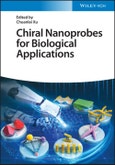Chirality has been the centerpiece of many multidisciplinary fields within the broader umbrella of the sciences. Recent advancements in nanoscience have spurred a growing interest in the dynamic field of chiral nanomaterials. In particular, the recent breakthroughs in chiral nanocrystals have presented an intriguing avenue whose potential application may address some key issues at the heart of nanosciences. While little attention has been focused on the biological implications of such advances, this arena is attracting theoretical and applicative interests.
Seeking to provide a thorough introduction to the field as well as fill this gap in scholarship, Chiral Nanoprobes for Biological Applications first provides a comprehensive review of the state-of-the-art development of strong chiroptical nanomaterials, describing how a synthesis and self-assembly approach can enable one to design and create a number of functional chiral nanomaterials. From there, the authors discuss the biological applications of chiral nanomaterials, such as extracellular bioanalysis, intracellular bioanalysis, and chiral recognition, as well as photothermal and photodynamics therapy. In doing so, the book seeks emphasize the potential in multidisciplinary approaches to this up-and-coming field.
Chiral Nanoprobes for Biological Applications readers will also find: - A particular emphasis on milestones achieved for key chiral nanoprobes research from the last five years - A discussion of future research directions - A helpful guide for new researchers and established professionals alike
Chiral Nanoprobes for Biological Applications is a useful reference for materials scientists, biochemists, protein chemists, stereo chemists, polymer chemists, and physical chemists. It is also a useful tool for libraries.
Table of Contents
Preface ix
1 Introduction 1
Chuanlai Xu, Hua Kuang, and Liguang Xu
1.1 Chirality and Asymmetry 1
1.2 Chiral Origin of Nanomaterials 2
1.2.1 Chiral Geometries of Nanoparticles 2
1.2.2 Structural Origins of Chirality 6
1.3 Relationship with Known Chiral Materials 10
1.3.1 Similarity to Chiral Inorganic and Organic Molecules 10
1.3.2 Similarity to Biological Nano- and Mesoscale Compounds 11
1.3.3 Hierarchical Chirality 11
1.4 Characterization Methods 12
1.4.1 Optical Spectra of Chiral Nanostructures 12
1.4.2 Methodological Aspects for Computational Studies 14
1.4.3 Selected Computer Modeling Study 17
References 20
2 Chiral Nanocrystals 27
Chuanlai Xu, liguang Xu, and Si li
2.1 Synthetic Methods 28
2.2 Chiral Semiconductors 29
2.2.1 Semiconductor Nanoparticles 29
2.2.2 Semiconductor Helicoids 38
2.3 Chiral Metal Nanostructures 40
2.3.1 Metal Nanoparticles/Nanorods 41
2.3.2 Metal Nanohelices 50
2.3.3 Metal Nanorings and Superstructures 54
2.4 Chiral Metallic Compound Nanoparticles 59
2.4.1 Chiral Oxide Nanoparticles 59
2.4.2 Chiral Sulfide/Selenide Nanoparticles 64
2.4.3 Ceramic Nanohelices 69
References 71
3 Chiral Nanoassemblies 79
Chuanlai Xu, Xiaoling Wu, and Changlong Hao
3.1 Twisted Nanorod Pairs 80
3.2 Chiral Nanoparticle Dimers 85
3.3 Tetramer Assemblies 90
3.4 Nanoparticle Helices 100
3.5 Chiral Nanochains 111
3.6 Core-Satellite Nanoassembly 113
3.7 Nanoplatelets and Chiral Films 129
3.8 Chiral Supraparticles 134
References 139
4 Chiral Nanostructures for Biorecognition and Bioanalysis 149
Chuanlai Xu, Yuan Zhao, and Xiaoling Wu
4.1 Chiral Analysis Strategy 149
4.2 DNA Detection 150
4.3 Biomarker Bioanalysis 156
4.4 Enzyme Bioanalysis 164
4.5 Metal Ion Bioanalysis 170
4.6 Small Molecule Detection 175
4.7 Chiral Recognition 184
4.8 Future Prospects and Outlook 193
References 193
5 Chiral Nanomaterials for Emerging Biological Effects 199
Chuanlai Xu, Maozhong Sun, and Yuan Zhao
5.1 Photothermal Therapy 199
5.2 Photodynamic Therapy 209
5.3 Multimodal Therapy Methods 220
5.4 Photochemical Effects 233
5.5 Future Prospects and Outlook 237
References 237
6 Chiral Nanomaterials for Biocatalysis 241
Chuanlai Xu, Wei Ma, and Hua Kuang
6.1 Chiral Nanomaterials Based Enantioselectivity in Biocatalysis 241
6.2 Biocatalysis of Chiral Drugs and Related Chemical Intermediates Based on Chiral Nanomaterials 249
6.3 Biocatalysis of Peptides Based on Chiral Nanomaterials 257
6.4 Biocatalysis of Biological Macromolecules Based on Chiral Nanomaterials 261
6.5 Biocatalysis Based on Enzyme-Encoded Chiral Complex Nanomaterial System 264
6.6 Chiral Nanomaterials Based Biocatalysis In Situ for Emerging Biological Applications 269
References 282
Index 287








